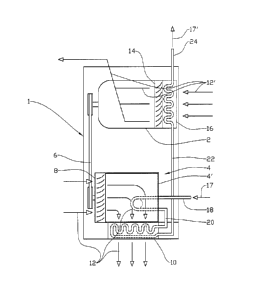Some of the information on this Web page has been provided by external sources. The Government of Canada is not responsible for the accuracy, reliability or currency of the information supplied by external sources. Users wishing to rely upon this information should consult directly with the source of the information. Content provided by external sources is not subject to official languages, privacy and accessibility requirements.
Any discrepancies in the text and image of the Claims and Abstract are due to differing posting times. Text of the Claims and Abstract are posted:
| (12) Patent: | (11) CA 2782003 |
|---|---|
| (54) English Title: | BREATHING AIR UNIT |
| (54) French Title: | UNITE D'AIR DE RESPIRATION |
| Status: | Granted |
| (51) International Patent Classification (IPC): |
|
|---|---|
| (72) Inventors : |
|
| (73) Owners : |
|
| (71) Applicants : |
|
| (74) Agent: | NORTON ROSE FULBRIGHT CANADA LLP/S.E.N.C.R.L., S.R.L. |
| (74) Associate agent: | |
| (45) Issued: | 2017-08-01 |
| (86) PCT Filing Date: | 2010-12-02 |
| (87) Open to Public Inspection: | 2011-06-16 |
| Examination requested: | 2015-06-08 |
| Availability of licence: | N/A |
| (25) Language of filing: | English |
| Patent Cooperation Treaty (PCT): | Yes |
|---|---|
| (86) PCT Filing Number: | PCT/NO2010/000441 |
| (87) International Publication Number: | WO2011/071388 |
| (85) National Entry: | 2012-05-25 |
| (30) Application Priority Data: | ||||||
|---|---|---|---|---|---|---|
|
A breathing air unit (1) comprising an electric motor (2) for driving a compressor (4), wherein compressed air is conducted through a first heat exchanger (10) cooled by cooling air of the compressor (4), and wherein the compressed air is conducted through a second heat exchanger (16) being cooled by cooling air of the motor (2).
L'invention concerne une unité d'air de respiration (1) comprenant un moteur électrique (2) permettant d'entraîner un compresseur (4), l'air comprimé étant conduit à travers un premier échangeur de chaleur (10) refroidi par l'air de refroidissement du compresseur (4), et l'air comprimé étant conduit à travers un second échangeur de chaleur (16) qui est refroidi par l'air de refroidissement du moteur (2).
Note: Claims are shown in the official language in which they were submitted.
Note: Descriptions are shown in the official language in which they were submitted.

For a clearer understanding of the status of the application/patent presented on this page, the site Disclaimer , as well as the definitions for Patent , Administrative Status , Maintenance Fee and Payment History should be consulted.
| Title | Date |
|---|---|
| Forecasted Issue Date | 2017-08-01 |
| (86) PCT Filing Date | 2010-12-02 |
| (87) PCT Publication Date | 2011-06-16 |
| (85) National Entry | 2012-05-25 |
| Examination Requested | 2015-06-08 |
| (45) Issued | 2017-08-01 |
There is no abandonment history.
Last Payment of $263.14 was received on 2023-11-09
Upcoming maintenance fee amounts
| Description | Date | Amount |
|---|---|---|
| Next Payment if standard fee | 2024-12-02 | $347.00 |
| Next Payment if small entity fee | 2024-12-02 | $125.00 |
Note : If the full payment has not been received on or before the date indicated, a further fee may be required which may be one of the following
Patent fees are adjusted on the 1st of January every year. The amounts above are the current amounts if received by December 31 of the current year.
Please refer to the CIPO
Patent Fees
web page to see all current fee amounts.
| Fee Type | Anniversary Year | Due Date | Amount Paid | Paid Date |
|---|---|---|---|---|
| Registration of a document - section 124 | $100.00 | 2012-05-25 | ||
| Application Fee | $400.00 | 2012-05-25 | ||
| Maintenance Fee - Application - New Act | 2 | 2012-12-03 | $100.00 | 2012-05-25 |
| Maintenance Fee - Application - New Act | 3 | 2013-12-02 | $100.00 | 2013-10-21 |
| Maintenance Fee - Application - New Act | 4 | 2014-12-02 | $100.00 | 2014-10-07 |
| Request for Examination | $800.00 | 2015-06-08 | ||
| Maintenance Fee - Application - New Act | 5 | 2015-12-02 | $200.00 | 2015-10-21 |
| Maintenance Fee - Application - New Act | 6 | 2016-12-02 | $200.00 | 2016-10-05 |
| Final Fee | $300.00 | 2017-06-20 | ||
| Maintenance Fee - Patent - New Act | 7 | 2017-12-04 | $200.00 | 2017-10-24 |
| Maintenance Fee - Patent - New Act | 8 | 2018-12-03 | $200.00 | 2018-11-13 |
| Maintenance Fee - Patent - New Act | 9 | 2019-12-02 | $200.00 | 2019-11-21 |
| Maintenance Fee - Patent - New Act | 10 | 2020-12-02 | $250.00 | 2020-11-19 |
| Maintenance Fee - Patent - New Act | 11 | 2021-12-02 | $255.00 | 2021-11-03 |
| Maintenance Fee - Patent - New Act | 12 | 2022-12-02 | $254.49 | 2022-11-11 |
| Maintenance Fee - Patent - New Act | 13 | 2023-12-04 | $263.14 | 2023-11-09 |
Note: Records showing the ownership history in alphabetical order.
| Current Owners on Record |
|---|
| E INNOVATION AS |
| Past Owners on Record |
|---|
| None |